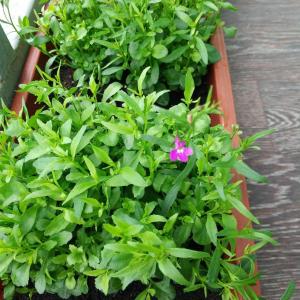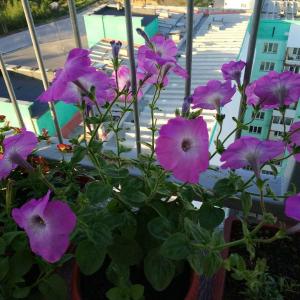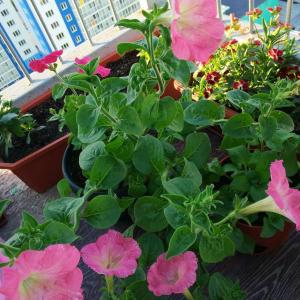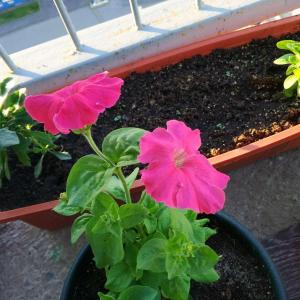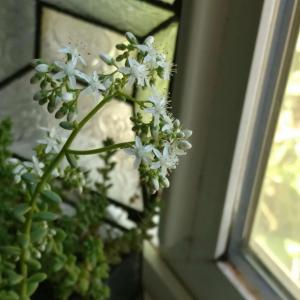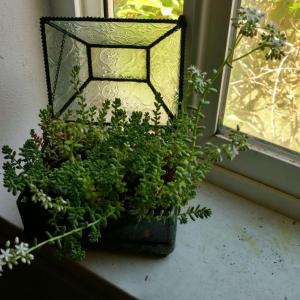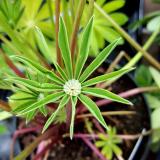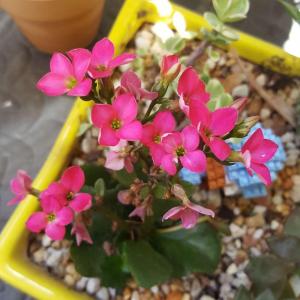文章
Dummer. ゛☀
2017年07月01日

Herba Dianthi nickname
The nickname is yemai, Dianthus stone flowers, flowers, ten kinds of landscape flower, mountain bamboo Dianthus, red flowers, nadeshiko.
The growth habit of Herba Dianthi
Herba Dianthi farming is simple plant breeding by pouring, planting and breeding, can also carry out ramet reproduction.
Herba Dianthi requirements of the soil is high, the general choice of well drained sandy soil is good. Water on the growth of Herba Dianthi is very important, need to pay attention to, not too dry or overwatered, ensure proper water can be. Fertilization, usually 3 times a year topdressing.
The value of Herba Dianthi
Herba Dianthi can do potted flowers for breeding, can also be raised in the flower, it has high medicinal value, can treat a variety of diseases. Will be made into Herba Dianthi pesticide, insecticide can.
Morphological character
Herbs perennial, 50-60 cm tall, sometimes taller. Stems tufted, erect, green, glabrous, Kobe Bunmie. Leaves linear lanceolate, 5-10 cm long, 3-5 mm wide, apex acute, midvein prominent, base forming sheaths, green, sometimes with pink green. Leaves opposite, more wrinkled, flattened, blade striped to lanceolate. Stems terete, with branches above, 30~60 cm long, surface pale green or yellow green, smooth, glabrous, nodes distinct, slightly inflated, hollow in section. Branches with flowers and fruits, calyx tube shaped, 2.7~3.7 cm long; bracts 4~6, broadly ovate, 1/4 long, calyx tube, petals brown, purple or brownish yellow, curly, apex deeply filiform. Capsule long tubular, as long as persistent calyx. Spend 1 or 2 lives under the top branch end, sometimes axillary; bracts obovate, 2-3, 6-10 mm long, about calyx 1/4, 4-5 mm wide, apex long acuminate; calyx cylindric, 2.5-3 cm long, 3-6 mm in diam., often dyed purple halo, calyx teeth lanceolate, 4-5 mm long; petals claw 4-5 cm long, 1.5-3 cm long, wrapped in a calyx tube, petals broadly obovate, margin of their cleft to middle or above middle, usually pale red or purplish, thin white, throat with silk hair like scales; stamens and style slightly exserted. The capsule is cylindrical, with persistent calyx length or slightly long, flat top 4 crack; seed ovoid, ca.



The nickname is yemai, Dianthus stone flowers, flowers, ten kinds of landscape flower, mountain bamboo Dianthus, red flowers, nadeshiko.
The growth habit of Herba Dianthi
Herba Dianthi farming is simple plant breeding by pouring, planting and breeding, can also carry out ramet reproduction.
Herba Dianthi requirements of the soil is high, the general choice of well drained sandy soil is good. Water on the growth of Herba Dianthi is very important, need to pay attention to, not too dry or overwatered, ensure proper water can be. Fertilization, usually 3 times a year topdressing.
The value of Herba Dianthi
Herba Dianthi can do potted flowers for breeding, can also be raised in the flower, it has high medicinal value, can treat a variety of diseases. Will be made into Herba Dianthi pesticide, insecticide can.
Morphological character
Herbs perennial, 50-60 cm tall, sometimes taller. Stems tufted, erect, green, glabrous, Kobe Bunmie. Leaves linear lanceolate, 5-10 cm long, 3-5 mm wide, apex acute, midvein prominent, base forming sheaths, green, sometimes with pink green. Leaves opposite, more wrinkled, flattened, blade striped to lanceolate. Stems terete, with branches above, 30~60 cm long, surface pale green or yellow green, smooth, glabrous, nodes distinct, slightly inflated, hollow in section. Branches with flowers and fruits, calyx tube shaped, 2.7~3.7 cm long; bracts 4~6, broadly ovate, 1/4 long, calyx tube, petals brown, purple or brownish yellow, curly, apex deeply filiform. Capsule long tubular, as long as persistent calyx. Spend 1 or 2 lives under the top branch end, sometimes axillary; bracts obovate, 2-3, 6-10 mm long, about calyx 1/4, 4-5 mm wide, apex long acuminate; calyx cylindric, 2.5-3 cm long, 3-6 mm in diam., often dyed purple halo, calyx teeth lanceolate, 4-5 mm long; petals claw 4-5 cm long, 1.5-3 cm long, wrapped in a calyx tube, petals broadly obovate, margin of their cleft to middle or above middle, usually pale red or purplish, thin white, throat with silk hair like scales; stamens and style slightly exserted. The capsule is cylindrical, with persistent calyx length or slightly long, flat top 4 crack; seed ovoid, ca.



0
0
Ueca
2017年07月01日

Kitty approves of the flowers.


4
0
Ueca:What is this plant? I would've guessed Pachyphytum oviferum, but the flower stalks are emerging directly from the soil.
meriunkat:so cute 😆
文章
Dummer. ゛☀
2017年07月01日

Lycoris; Lycoris; Lycoris
Another name for brocade flowers
Lycoris radiata, Latin name: Lycoris, sprengeri, Comes, ex, Baker
Brocade flower producing area
Originated from the middle and lower reaches of the Yangtze River in China, it is distributed in Anhui, Jiangsu, Zhejiang and Hubei. How is the growth of shade environment, is a kind of very shade tolerant plants.
Morphological characteristics of brocade flowers
L.sprengeri is a kind of herb, garlic bulb and the like, oval leaves and daffodils; similar zonal stems; about 60 centimeters high, umbels, 4-6 flower, flower color is purple red flowers, lobes short blue color, dense, like a watercolor painting; corolla length is 1 cm, stamen and perianth style subequal, slightly longer than perianth, very cute.
Flower growth habit
Change brocade flowers like sunny moist environment, for example, bleak hillside, rock, in the semi overcast and dry environment can survive, a little cold, tenacious vitality. Not fastidious about the soil, but growing more exuberant in the fertile, breathable soil, with more flowers and more showy flowers. In summer very hot and cold conditions will enter the sleep state.
Change brocade flower language culture
Separation and grief
Reproductive mode
Under natural conditions, l.sprengeri seed, and the germination rate is very low, so the general use of asexual propagation methods.
Ramet method
The easiest way is to take the ramets, plants will dig out in the dormant period or after flowering, the epiphytic ball off near the cue ball planting, about a year or two can flower.
Scale induction and Plantlet Regeneration
Stripped of brown scales and dry bulb outer scales, resection of neck and root ball, after washing with water and ethanol disinfection solution of mercuric chloride. The bulb is divided into six parts, each containing 2~8 flake, inoculated in culture medium for inducing axillary bud, or bulb split into two, four, eight parts, placed directly in the induction medium of axillary buds; axillary or adventitious buds after transfer to medium bulb; will have little leaf the bulb on rooting culture medium for rooting. The regenerated plantlets were transplanted into commercially cultured soil.
Main use
Medical
L.sprengeri bulbs for extracting galantamine raw materials. Have jiedusanjietang treatment, sore throat, skin and other effects, scrofulous sore furuncle carbuncle swollen.
Usually in the spring and autumn, the wild or cultivated 2-3 years after the bulb, wash, dry, or slice dried. When in use, external use, mash and apply to the affected area can be.
Watch
L.sprengeri in the garden, as forest cover flower, flower border vegetation or rocks between natural style planting. Because of its flowering time and leaf, it should be more open herbaceous plants collocation as well. Planting density is 15-20 cm spacing, row spacing of 40 cm, planting 1 rows of other evergreen lines.
In addition, a scape robust characteristics, stem length, is the ideal material for cut flowers.



Another name for brocade flowers
Lycoris radiata, Latin name: Lycoris, sprengeri, Comes, ex, Baker
Brocade flower producing area
Originated from the middle and lower reaches of the Yangtze River in China, it is distributed in Anhui, Jiangsu, Zhejiang and Hubei. How is the growth of shade environment, is a kind of very shade tolerant plants.
Morphological characteristics of brocade flowers
L.sprengeri is a kind of herb, garlic bulb and the like, oval leaves and daffodils; similar zonal stems; about 60 centimeters high, umbels, 4-6 flower, flower color is purple red flowers, lobes short blue color, dense, like a watercolor painting; corolla length is 1 cm, stamen and perianth style subequal, slightly longer than perianth, very cute.
Flower growth habit
Change brocade flowers like sunny moist environment, for example, bleak hillside, rock, in the semi overcast and dry environment can survive, a little cold, tenacious vitality. Not fastidious about the soil, but growing more exuberant in the fertile, breathable soil, with more flowers and more showy flowers. In summer very hot and cold conditions will enter the sleep state.
Change brocade flower language culture
Separation and grief
Reproductive mode
Under natural conditions, l.sprengeri seed, and the germination rate is very low, so the general use of asexual propagation methods.
Ramet method
The easiest way is to take the ramets, plants will dig out in the dormant period or after flowering, the epiphytic ball off near the cue ball planting, about a year or two can flower.
Scale induction and Plantlet Regeneration
Stripped of brown scales and dry bulb outer scales, resection of neck and root ball, after washing with water and ethanol disinfection solution of mercuric chloride. The bulb is divided into six parts, each containing 2~8 flake, inoculated in culture medium for inducing axillary bud, or bulb split into two, four, eight parts, placed directly in the induction medium of axillary buds; axillary or adventitious buds after transfer to medium bulb; will have little leaf the bulb on rooting culture medium for rooting. The regenerated plantlets were transplanted into commercially cultured soil.
Main use
Medical
L.sprengeri bulbs for extracting galantamine raw materials. Have jiedusanjietang treatment, sore throat, skin and other effects, scrofulous sore furuncle carbuncle swollen.
Usually in the spring and autumn, the wild or cultivated 2-3 years after the bulb, wash, dry, or slice dried. When in use, external use, mash and apply to the affected area can be.
Watch
L.sprengeri in the garden, as forest cover flower, flower border vegetation or rocks between natural style planting. Because of its flowering time and leaf, it should be more open herbaceous plants collocation as well. Planting density is 15-20 cm spacing, row spacing of 40 cm, planting 1 rows of other evergreen lines.
In addition, a scape robust characteristics, stem length, is the ideal material for cut flowers.



0
0
文章
Dummer. ゛☀
2017年06月30日

Nemesia the nickname
Nemesia, also called capsule from flowers, love honey West, resistance in moesia.
The growth habit of the nemesia
Nemesia is love and warm sunny climate plants in aquaculture nemesia, more afraid of high temperature, so the summer should pay attention to cool. When selecting soil, nemesia generally choose loose fertile and good drainage and humus rich soil.
Nemesia role
Nemesia delicate flowers, in fact, its main role is to watch.
Nemesia especially odd induced flowers, if tall varieties can be used as cut flowers for ornamental. Dwarf variety is more suitable for potted cultivation, breeding or in the flower inside, are ornamental.
Morphological character
Plant height 30 - 60cm, much branch. Leaves opposite, basal, Ye Changyuan - shaped, spatulate, entire, cauline leaves lanceolate.
Racemes from branch top, about 100cm, corymbose.
The base is pocket shaped.
The color changeable, white, yellowish white, yellow, dark yellow, orange, red and purple rose; yellow throat, dark spots and whiskers.
Flowering spring and summer.
In autumn or spring, optimum temperature of 15 DEG C, about 10 days of germination. High stem flowers can be cut short, suitable for potted plants, or for beds.


Nemesia, also called capsule from flowers, love honey West, resistance in moesia.
The growth habit of the nemesia
Nemesia is love and warm sunny climate plants in aquaculture nemesia, more afraid of high temperature, so the summer should pay attention to cool. When selecting soil, nemesia generally choose loose fertile and good drainage and humus rich soil.
Nemesia role
Nemesia delicate flowers, in fact, its main role is to watch.
Nemesia especially odd induced flowers, if tall varieties can be used as cut flowers for ornamental. Dwarf variety is more suitable for potted cultivation, breeding or in the flower inside, are ornamental.
Morphological character
Plant height 30 - 60cm, much branch. Leaves opposite, basal, Ye Changyuan - shaped, spatulate, entire, cauline leaves lanceolate.
Racemes from branch top, about 100cm, corymbose.
The base is pocket shaped.
The color changeable, white, yellowish white, yellow, dark yellow, orange, red and purple rose; yellow throat, dark spots and whiskers.
Flowering spring and summer.
In autumn or spring, optimum temperature of 15 DEG C, about 10 days of germination. High stem flowers can be cut short, suitable for potted plants, or for beds.


0
0
文章
linpei
2017年06月30日

Roses and roses and roses look the same, but not really. The cultivation of rose flowers need to pay attention to what aspects, and then from the soil, water, fertilizer, pruning and so on several aspects to introduce to you about the cultivation methods of roses.
About soil:
Roses do not select soil, but whether they are planted or planted, they are best grown in sandy soil rich in humus.
About moisture:
Rose like run and afraid of wet avoid waterlogging, from germination to flowering, water can be more appropriate to pouring a little, but not for the degree of soil moist waterlogging, after watering flowers can not be too much to see the soil dry and wet, rainy season should pay attention to drainage.
About fertilizer:
It is also like fertilizer, barren, March can be 1 to 2 times with nitrogen based fertilizer, promote the growth of branches, April, May 2 times to 3 times the phosphorus and potassium based fertilizers, and promote its multi bud flowering, after flowering Zaishi a rejuvenation after fertilizer can no longer rose fertilization system positive flower, it is warm, cold, North and south, can overwinter safely outdoors.
About pruning:
The germination ability of the rose is vigorous and the growth is luxuriant. If it is not pruned in time, it is easy to produce diseases and insect pests under the condition of hot and humid, lack of light and poor ventilation. Therefore, a pruning should be carried out after the flower.
About plant diseases and insect pests:
In the rainy and humid, poor ventilation, poor sunshine conditions rose susceptible to powdery mildew, once discovered will cut the diseased branches destroyed, in order to avoid infection, and spraying low concentration of LSSS or Bordeaux, Topsin solution, to prevent the spread of the disease.
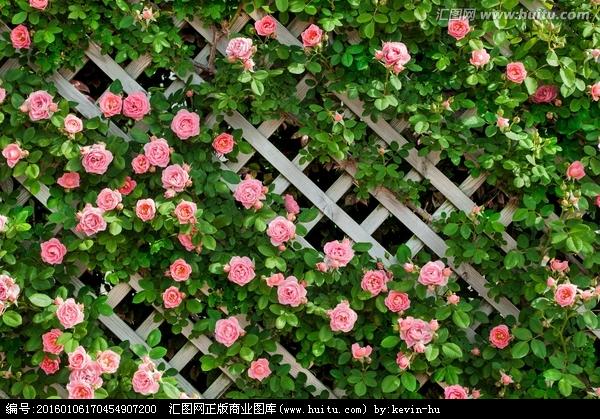
About soil:
Roses do not select soil, but whether they are planted or planted, they are best grown in sandy soil rich in humus.
About moisture:
Rose like run and afraid of wet avoid waterlogging, from germination to flowering, water can be more appropriate to pouring a little, but not for the degree of soil moist waterlogging, after watering flowers can not be too much to see the soil dry and wet, rainy season should pay attention to drainage.
About fertilizer:
It is also like fertilizer, barren, March can be 1 to 2 times with nitrogen based fertilizer, promote the growth of branches, April, May 2 times to 3 times the phosphorus and potassium based fertilizers, and promote its multi bud flowering, after flowering Zaishi a rejuvenation after fertilizer can no longer rose fertilization system positive flower, it is warm, cold, North and south, can overwinter safely outdoors.
About pruning:
The germination ability of the rose is vigorous and the growth is luxuriant. If it is not pruned in time, it is easy to produce diseases and insect pests under the condition of hot and humid, lack of light and poor ventilation. Therefore, a pruning should be carried out after the flower.
About plant diseases and insect pests:
In the rainy and humid, poor ventilation, poor sunshine conditions rose susceptible to powdery mildew, once discovered will cut the diseased branches destroyed, in order to avoid infection, and spraying low concentration of LSSS or Bordeaux, Topsin solution, to prevent the spread of the disease.

3
0
dIgfi34ly59
2017年06月27日

Can anyo identify this plant? I live in the Pacific Northwest; this, clearly, isn't a native species, but it was here when I bought the house. The three photos show an overall view, the leafy base, and the budding flowers at the top of the woody stem. This beautiful plant is in a drip-irrigated rock garden.






0
0
成长记
Elena Galkina
2017年06月17日

All light seeds died. Only dark seeds' plants survived and now they bloom with dark red flowers
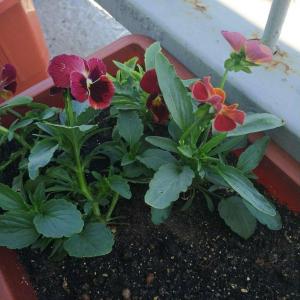

1
0
成长记
Lucky Coyote
2017年06月13日

Two new shoots, possibly flowers, I just noticed in this variety pot 😺
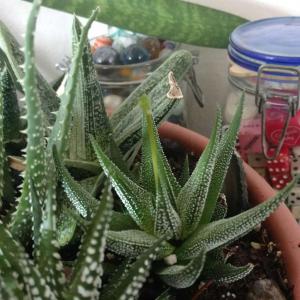
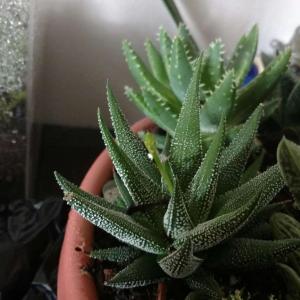


2
0
求助
elvenking42
2017年06月09日

I picked up this beautiful Echeveria today with two flowerstalks ready to bloom.
my first question is if anyone can tell me what type of Echeveria it is? it's very small, maybe 3 inches across. the flowers appear to maybe be pink or yellow but the buds have not booked yet.
My second question if anyone knows is if I can let this bloom and it will still live? I know many types of succulents will die or at least go dormant after blooming, I would really love to see the blooms but I'm not willing to sacrifice my entire plant just to see them
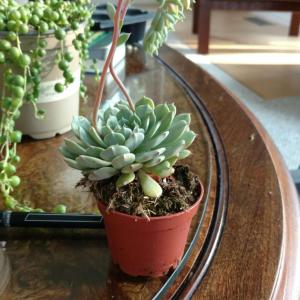
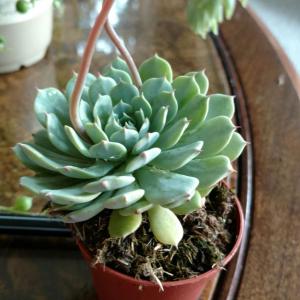
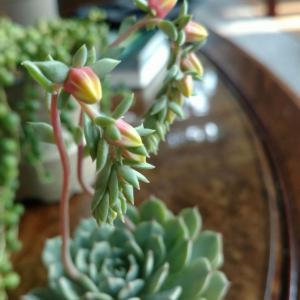
my first question is if anyone can tell me what type of Echeveria it is? it's very small, maybe 3 inches across. the flowers appear to maybe be pink or yellow but the buds have not booked yet.
My second question if anyone knows is if I can let this bloom and it will still live? I know many types of succulents will die or at least go dormant after blooming, I would really love to see the blooms but I'm not willing to sacrifice my entire plant just to see them



4
1
AloeYouVeraMuch:It will live! Also you have a lovely echeveria elegans! It tends to get pretty big so repotting may be in order soon.
meriunkat:I've had succulents that have flowerstalks the plant itself does not die, the flowers do tend to dry after blooming though
Frajille:Just do not over water it. I killed one before. They like to be dry mostly.
T.C.:It will live after blooming. Don't worry.
求助
YiLam
2017年06月08日

I just got this new echeveria few days ago and as you can see there's 2 "flowers" who are connected by the same stem. I'm wondering if I can cut the stem in 2 to separate it.
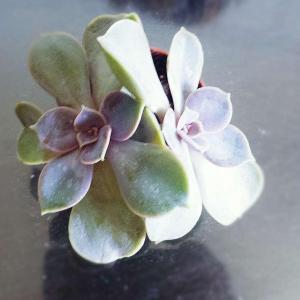

2
0
YiLam:@Ueca okay thanks
Ueca:You can cut it, but you should wait for the cut wound to dry into a scab if you want to plant the cut-off head.


